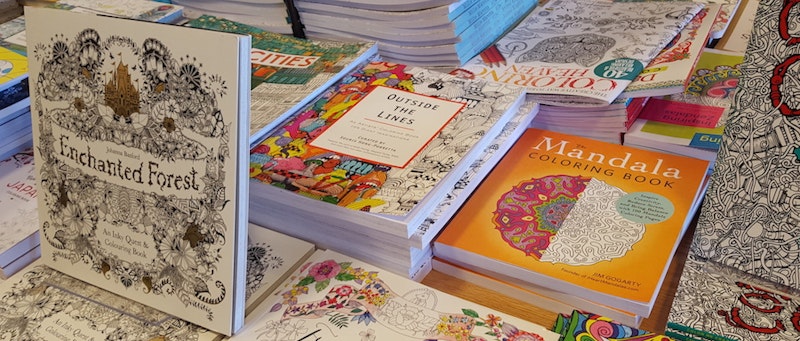Katy Ross started coloring at age two – and never stopped. When stress or insomnia sends her mind reeling, the now 30-year-old charity worker from Richmond, California, flips open one of her 20 coloring books. “It can be very peaceful,” she says. A soothing coloring session with a friend worried about a doctor’s appointment inspired Ross to start the Oakland Coloring for Fun and Relaxation Meetup in August. Every other Sunday, a dozen or so of its 120-plus members gather at a local café, books and supplies in tow.
The coloring craze is catching on in a big way. Ross’ group is one of many that have recently cropped up in towns and cities all over the country. Coloring books once tucked away in specialty bookstores are now on display at major stores like Barnes and Noble and Michael’s. Some even rank among Amazon’s top 20 best-sellers, including British illustrator Johanna Basford’s Secret Garden and Enchanted Forest.
Basford helped coax coloring books into the grown-up world in 2013 with the release of Secret Garden,which has sold around 7 million copies so far. Its pages are abloom with whimsical flora and fauna. Since then, coloring clubs have emerged throughout the UK before making their way stateside.
Unlike their kiddie counterparts, adult coloring books often feature intricate designs, like landscapes and mandalas. Many trace their appeal to a potential to lower stress and promote mindfulness — awareness of the present without self-judgment — shown to improve physical health and well-being. While coloring doesn’t require artistic skill, the designs are complex enough to sustain concentration, which “calms and eases emotional tension,” says Jamie Derrick, an assistant professor of psychology at the University of Idaho.
Psychologists aren’t surprised. Despite a dip since the 2007-10 recession, Americans still experience unhealthy stress levels, according to the American Psychological Association, and the National Institutes of Mental Health estimates that nearly one in five has an anxiety disorder. Coloring “is a very inexpensive way of…taking a little vacation,” says Miami-based art therapist Patricia Isis.
Studies suggest that coloring can indeed alleviate anxiety. A McGill University study published in the Journal of Applied School Psychology in August found that children who colored in a mandala before a spelling test experienced lower anxiety levels than those asked to color on a blank sheet of paper, and a 2012 Nazareth University study noted similar findings in college students. But experts caution that the research is still in its infancy, and the findings might not apply to adults.
So how might coloring calm the mind? Like meditation, the repetitive motions of knitting and drawing have been shown to turn on the parasympathetic nervous system, responsible for the “rest and digest” response, which involves slowing the heart rate and stimulating digestion. Coloring is similarly rhythmic.
The process of coloring also seems to foster mindfulness, which can be linked to lowered blood pressure and improved sleep, among other benefits. “You don’t need to make any decision except for color,” freeing the mind to relax, Derrick says. “The internal critic isn’t going to surface.... There’s no failure. You’re going to color it in, and it’s going to be beautiful.” Yet the intricacy of the designs also keeps us engaged, and the process of filling in one space after the next produces a sense of satisfaction and completion, like checking off a to-do list.
“It’s an artistic outlet that doesn’t stress me out,” says Ross, who enjoys coloring paisleys and mandalas, as well as more realistic designs, depending on her mood. “It doesn’t make me think about perfection…. I don’t have to think about shapes. I use color as my medium for creating art.”
She adds that coloring is also just fun. Some therapists agree and see coloring as a form of play — an activity without a clear purpose done for the sheer pleasure of it, even while alone. Research shows that play can boost problem-solving skills, creativity, and emotional well-being. Derrick notes that we might enjoy using color to express emotions, or use different coloring media to evoke certain sensory experiences — the feel of coloring with a Sharpie versus a crayon, for example. “Humans enjoy that,” she says. “It’s savoring…and connected to satisfying pleasure, not those quick pleasures you wish you hadn’t done.”
If you’d like to pick up coloring again, there are no shortage of great options. Look for a theme that helps you escape to your happy place, whether it’s tropical forest scenes, intricate cityscapes, or meditative mandalas. Basford’s books are great choices, with their bold lines and heavy creamy paper that works well with colored pencils and crayons. Others, like Millie Malotta’s Tropical World and Animal Kingdom, feature fine-lined patterns on smoother paper that makes a nice medium for markers.
But Derrick cautions against relying too heavily on coloring over meditation or yoga, even if it offers an easier route to mindfulness for some. Unlike coloring, these more formal practices do allow space for self-critical and other negative feelings to arise, better preparing us to encounter them in day-to-day life. And coloring isn’t for everyone — some might find it boring or frustrating. Perhaps more important, it isn’t a substitute for therapy. Those who want to address emotional trauma or mental illness should seek help from a licensed psychologist.
While some see the coloring frenzy dying down eventually, many see it lasting as long as stress does. “People are getting really stressed out with adulthood and wanting something that reminds them of their childhood,” Ross says. “I think it could definitely last for a long time.”
Selected references:
American Psychological Association. Stress in America: Paying With Our Health. February 2015. [Link]
Benefits of Mindfulness: Practices for Improving Emotional and Physical Well-Being. Adapted from Positive Psychology, a report by the editors of Harvard Health Letters. HelpGuide.org.
The Benefits of Play for Adults: How Play Can Improve Your Health, Work, and Family Relationships. HelpGuide.org. [Link]
Stuart Brown, MD. Play: How It Shapes the Brain, Opens the Imagination, and Invigorates the Soul. New York: Avery, a member of Penguin Group; 2010. [Link]






